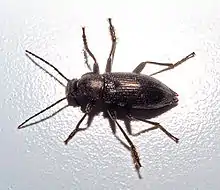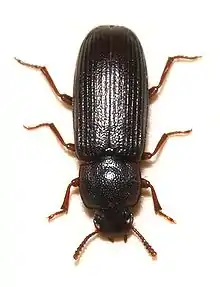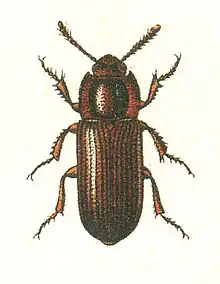Tenebrioninae
Tenebrioninae are a large subfamily of the darkling beetles (Tenebrionidae), containing, among others, the flour beetles.
| Tenebrioninae | |
|---|---|
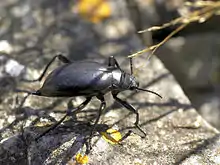 | |
| Blaps mortisaga of tribe Blaptini | |
| Scientific classification | |
| Kingdom: | |
| Phylum: | |
| Class: | |
| Order: | |
| Family: | |
| Subfamily: | Tenebrioninae Latreille, 1802 |
| Tribes | |
|
Around 20-30, see text | |
Many of these robust and usually mid-sized beetles have elytra with some sort of corrugation on the upperside. They are usually colored blackish, dark brown or grey, and often have a satiny sheen; they are generally not glossy (some are outright matte) and few are metallic. The body is shaped like a medication capsule or like a bullet; the legs can be short and stout or long and spindly. They eat both fresh and decaying vegetation, including vegetable produce, and several are commercially important pests of flour and other cereal products.
Tenebrioninae are eaten by large invertebrates and small vertebrates, such as birds, rodents, and lizards. The larval stages of several species are cultured as feeder insects for captive insectivores, and include mealworms and mini mealworms.
Notable species
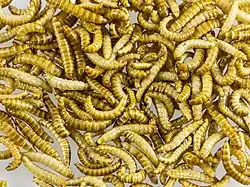
Larvae of the yellow mealworm beetle (Tenebrio molitor) are commonly used as food for terrestrial amniotes kept in terraria. Other Tenebrio and Tribolium species are also bred as animal food. The red flour beetle (Tribolium castaneum) is a popular genetics laboratory animal and model organism, especially in studies of intragenomic conflict and population ecology. Several species of Tenebrio and Tribolium, such as the confused flour beetle (T. confusum) and T. destructor, and other genera such as Gnathocerus cornutus, are pests of cereal and flour silos and other storage facilities.
Systematics
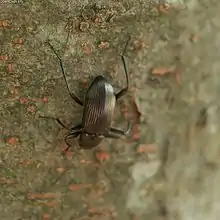
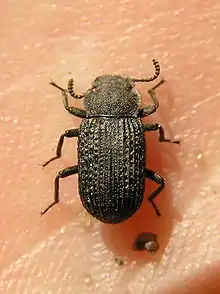
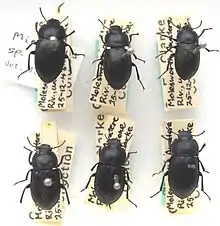
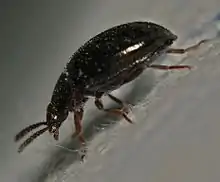
The Tenebrioninae are traditionally divided in some 20-30 tribes. The exact delimitation and validity of several of these is unclear. Molecular phylogenetic studies have yielded inconsistent results, perhaps due to hybridization, horizontal gene transfer by Wolbachia bacteria, and insufficient taxon sampling obfuscating the information contained in DNA sequence data.[1][2]
In some treatments, the Pimeliinae are included as yet another tribe. This may be correct, but as far as can be told they are a closely related but well distinct lineage of Tenebrionidae. The Opatrini are sometimes elevated to familial rank as Opatrinae. The Crypticini, Pentaphyllini, and Scaphidemini are sometimes placed here, but are more commonly located in the Diaperinae.[1][2]
The tribes (and some notable genera) include:
|
Acropteronini Doyen, 1989 (disputed)
Amarygmini Gistel, 1856
Apocryphini Lacordaire, 1859 (disputed)
|
Bolitophagini Kirby, 1837
Centronopini Doyen, 1989 (disputed) |
|
Dendarini Espanol, 1945 (sometimes in Pedinini)
|
Dissonomini Medvedev, 1968 (disputed)
|
Helopini Latreille, 1802
|
Helopinini Lacordaire, 1859 (disputed)
Leichenini Leng, 1920 (disputed)
Melanimini Seidlitz, 1894 (1854) Opatrini Brullé, 1832 |
|
Palorini Matthews, 2003
Pedinini Eschscholtz, 1829
Platyscelidini Lacordaire, 1859
Praeugenini De Moor, 1970 (disputed) Tenebrionini Latreille, 1802 (including Biuini)
|
Titaenini Fauvel, 1905
Toxicini Lacordaire, 1859
Triboliini Mulsant, 1854 (sometimes in Ulomini)
Ulomini Blanchard, 1845
|
In addition, the genus Aphtora is of uncertain placement in this subfamily.
References
- Angelini, D. R. & E. L. Jockusch. (2008). Relationships among pest flour beetles of the genus Tribolium (Tenebrionidae) inferred from multiple molecular markers. Molecular Phylogenetics and Evolution 46(1) 127-41. doi:10.1016/j.ympev.2007.08.017 (HTML abstract)
- Bouchard, P.; et al. (2005). "Synoptic classification of the world Tenebrionidae (Insecta: Coleoptera) with a review of family-group names" (PDF). Annales Zoologici. 55 (4): 499–530. Archived from the original (PDF) on 2016-03-03.
| Wikispecies has information related to Tenebrioninae. |
| Wikimedia Commons has media related to Tenebrioninae. |
